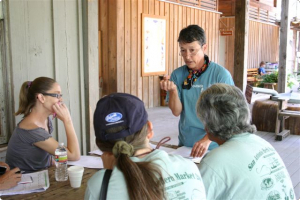Being an MLMP trainer is an exciting opportunity to share your knowledge and enthusiasm for monarchs, their habitats, and the MLMP. Our trainers make it possible to better engage project volunteers across the country. Your contributions as a trainer will help us gain a better understanding of monarch breeding populations in your area. Please review the trainer requirements and advice below to see if becoming an MLMP trainer is a good fit for you. We are grateful for your interest and are happy to help in any way that we can!
To be an MLMP trainer, you should feel comfortable with the following activities:

- Regular participation and reporting in at least one MLMP activity (required)
- Identifying monarch eggs and larvae at all instar stages
- Identifying milkweed species native to your area
- Discussing the different activities that MLMP offers (you don't have to participate in all of them, but you should be familiar with every activity)
- Using the MLMP website, including both the resources offered and the online data entry portal
- Speaking with or instructing small groups by phone, email, or in-person
If you feel that you are comfortable with the above activities and would like to be listed as an MLMP Local Trainer on our website, feel free to email us at info@mlmp.org to learn more.
If there are areas that you'd like to improve upon before being listed as a trainer, consider the following resources to help prepare you for this new role with the MLMP! As always, feel free to reach out to us for more information.
- Email MLMP (info@mlmp.org) with specific questions that you have.
- Familiarize yourself with monarch FAQ questions (MLMP's FAQs; MJV main website offers these here). These questions come up regularly, and you may get some of these questions from volunteers.
- Complete the MLMP online training and refer back to sections you feel less comfortable with. Check for any in-person trainings near you and utilize those opportunities.
- Take some time to review the Monarch Joint Venture's webinar series. These have great information on monarch biology, conservation, and research.
- Read all MLMP datasheet instructions to familiarize yourself with the protocols and techniques the project requires. Contact us for anything that needs clarification or further explanation.
- Familiarize yourself with the Results and Findings section to learn about how contributions to the MLMP are used to further our understanding of monarch biology and conservation. MLMP's papers are all available for download, so you can read those that interest you.
- Check out our For Trainers page under our Resources section for additional information and to announce a training session.
Once you become an MLMP trainer, here are a few things to keep in mind:

- If you have access to a particular space or venue, try to offer at least one training each year to recruit more volunteers in your area. You can advertise this training through our website by Announcing a Training Session. More resources and information for hosting a training session can be found on the For Trainers resource page here.
- Keep in contact with the network of volunteers that you have trained. It is important to keep them up-to-date with the relevant updates and information about the project and to maintain their enthusiasm for the project.
- Communicate with other MLMP trainers or MLMP staff to learn different techniques that they use to engage volunteers. Make sure to share any pointers you have with the MLMP that you have found work particularly well!
- Be a role model! Make sure your MLMP monitoring site is monitored regularly and data are reported so that you can provide an example of the project to volunteers who approach you.

